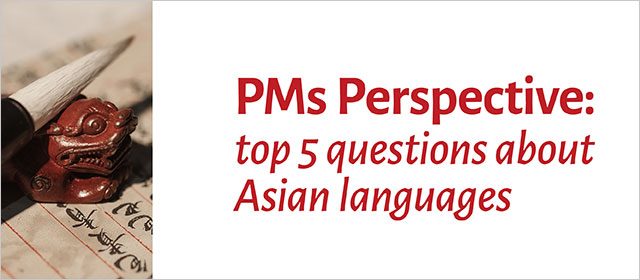I’ve been thinking about this topic for a while now and the topic has undergone quite a few transformations. My favorites were along the lines of “Top 5 questions about Asian languages?” “What to ask about Asian languages?” and etc. However, I was never fully satisfied with its scope until I realized something: there are no universal questions and answers and there is no top 5 without taking into account who is asking.
So I started digging and asking around – mainly colleagues of mine, who have experience in talking with our partners and posing the right questions. Sam Hardy and Rosen Ivanov have knowledge straight from the source as they’ve performed some training to partner’s account manager teams on the language services we deliver. I can’t take credit for all of this, and I just love how a joint team effort came out as this “simple” article. This is what we came up with: an article containing 5 questions and answers for language services professionals concerning the translation project management process.
#1: If you don’t speak the language, how can you process a translation project in it?
Maybe that will be shocking but only a limited number of our AMs speak the language they process. But…we’ve got a special trick up our sleeve here, so hear us out. For all the main languages we process we’ve got a special position in our company called Language Leader. This is the key person who decides who is gonna handle a specific project. The Language Leader is exactly what is implied by the name – skillful in the specific language and very well familiar with the strengths and knowledge of our linguists. So a project is not assigned without going through our Language Leader. Voila! Our AMs don’t need to know the language and this means yours don’t need to speak it, too.
#2: Where are your linguists located?
When it comes to Asian languages this is quite an important question due to the fact that some languages like Japanese evolve and change in time. To be skillful at translating this language the translator must be living in the country or at least lived in the said country.
Another reason for knowing the location of a translator is that sometimes language takes a different path based on the place where the people are living. Let’s take Hmong language as a second example – Hmong immigrants speak a different dialect than the Hmong located in Asian countries and so are Vietnamese living in the US. Knowing this an account manager will ask more questions to the customer in order to better understand the expected result.
#3: Word count or Character count?
Now that is a question that might require a separate article but I’ll try to sum it up in a few sentences. A lot of the Asian languages have very different writing systems from the Latin-based languages. The standard word count tools that we usually use don’t work so well and will mislead you as they don’t correctly identify words in most of the Asian languages might mislead you if you don’t take this into consideration.
Simple examples with Chinese language:
- Possible slip-up 1: Quote for the wrong type of Chinese on the document, which can lead to a difference in the price.
- Possible slip-up 2: If you have Chinese – English translation project and you give a quote without knowing the ratio between character/word, there might be a difference in the price you’ll give your client and the price we will charge you at the end. Best case scenario you just learn about it, before you make a serious mistake but worst-case scenario is you pay more than you’ve charged your client.
- Possible slip-up 3: If you don’t have the right package installed on your CAT tool for it to recognize the Asian language you are processing. End result will be the same as above.
To avoid these scenarios we strongly suggest to quote source characters or target words. Our recommendation to prevent these from happening is to always coordinate in advance with your Asian languages vendor and double-check your quote with them. This will save you from any misunderstanding and supply you with the correct information on time.
#4: Anything specific on CAT tools?
 Yes, of course. As almost everything related to the languages we work with, CAT tools also need some specific knowledge to operate with them properly. There are small details like punctuation for the language, segmentation, and what each CAT tool considers a segment sometimes clashes with the meaning itself, the examples are quite numerous. However, this doesn’t mean that CAT tools are useless, on the contrary, they are used but there are particular tools and ways to work with it for each language. Our account managers are trained to work with them and so are the linguists who perform the translation work in our company.
Yes, of course. As almost everything related to the languages we work with, CAT tools also need some specific knowledge to operate with them properly. There are small details like punctuation for the language, segmentation, and what each CAT tool considers a segment sometimes clashes with the meaning itself, the examples are quite numerous. However, this doesn’t mean that CAT tools are useless, on the contrary, they are used but there are particular tools and ways to work with it for each language. Our account managers are trained to work with them and so are the linguists who perform the translation work in our company.
#5: What about quality assurance?
As an ISO-certified company, we’ve got a straightforward quality assurance process. Our internal QA team performs an obligatory QA at a random 10% of all our workflow. However, if a client of ours requires all of its work to be checked, they need to stipulate this with us as a necessary step of the work process and we will apply their request.
In the end, I have to share with you that there are plenty of other questions out there, which can be answered about working with the languages in our portfolio. In the future, we intend to follow up with more content on the topic, so stay tuned. The current article is part of a series on the topic, which aims to put into the spotlight the processing of Asian languages and make it easier for you to work with them.
